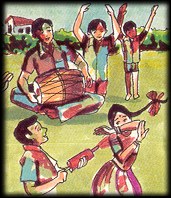  |  |
|
  |  |
|
The full-moon day in February-March is celebrated as Holi, the festival of colors. Holi is a festival of fun and gaiety for people of all ages. Bonfires are lit and people smear colors on each other.
 The mythological origin of this festival varies in north and South India. In the South, especially in Tamil Nadu and Kerala, it is believed that Kama Deva, the God of love, aimed his arrow at his wife Rati. The arrow hit Shiva by mistake. Kama was burnt to ashes by the fire coming out of the third eye of the enraged God. Rati, who was also the daughter of Shiva, was so grief-stricken that Shiva relented and granted his daughter the power to see her husband but without a physical form. In Tamil Nadu, the festival known as Kaman vizha, Kaman pandigai, or Kama Dahanam commemorates the burning of Kama. The mythological origin of this festival varies in north and South India. In the South, especially in Tamil Nadu and Kerala, it is believed that Kama Deva, the God of love, aimed his arrow at his wife Rati. The arrow hit Shiva by mistake. Kama was burnt to ashes by the fire coming out of the third eye of the enraged God. Rati, who was also the daughter of Shiva, was so grief-stricken that Shiva relented and granted his daughter the power to see her husband but without a physical form. In Tamil Nadu, the festival known as Kaman vizha, Kaman pandigai, or Kama Dahanam commemorates the burning of Kama.
In North India, grains and stalks saved from the year's harvest are offered to Agni, the God of Fire. Big bonfires are lit and effigies of Kama are burnt, usually late at night or in the early hours of the morning. Holi fire, is a symbol of destruction of all filth and impurity, physical and mental.  Legend has it that a mighty King Hiranyakasipu ordered his people to worship him as a God. But Prahlad, his only son, refused to accept his father as a God, because he believed only in Lord Vishnu. The King tried to kill his son, but everytime Prahlad was saved as he uttered the name of Vishnu. Finally, Prahlad's aunt Holika, claiming herself to be fireproof, took the child in her lap and sat in the fire to burn him alive. When the fire subsided, the king found, the child alive while Holika had perished. Legend has it that a mighty King Hiranyakasipu ordered his people to worship him as a God. But Prahlad, his only son, refused to accept his father as a God, because he believed only in Lord Vishnu. The King tried to kill his son, but everytime Prahlad was saved as he uttered the name of Vishnu. Finally, Prahlad's aunt Holika, claiming herself to be fireproof, took the child in her lap and sat in the fire to burn him alive. When the fire subsided, the king found, the child alive while Holika had perished.
Krishna, an incarnation of Vishnu, is worshipped too during Holi. In Mathura, where Lord Krishna spent his childhood, Holi is celebrated with song and dance in addition to the usual colourdaubing. |
| About India | Arts | Cuisine | Fairs | Festivals | Neighbours | Society | Religions |
| Site Map | Disclaimer | About Us | Write To Us |